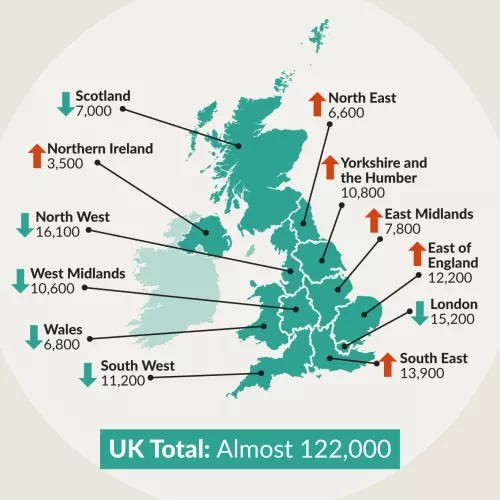Centrepoint has just released the latest round of figures from its Youth Homelessness Databank, which shows that between April 2020 and the end of March 2021, there were nearly 122,000 young people facing homelessness in the UK. This means that youth homelessness has continued to rise for every year that the Databank has been live.
Despite this year having seen major policy initiatives aimed at tackling homelessness and rough sleeping – including the Everybody In initiative, a temporary ban on evictions, and the temporary uplift in Universal Credit – the numbers of young people approaching their local authority for help has still increased.
The picture across the UK
In England, 104,400 young people presented as homeless or at risk of homelessness to their local authority in 2020/21, an increase of 2,300 (2 per cent) from the year prior (102,100). Northern Ireland also saw an increase, but Scotland and Wales saw slight decreases in the numbers compared to the previous financial year.

Homelessness in the UK
Within England, four of the nine regions saw a decrease in the numbers of young people presenting to their local authority as homeless. Of these, London and the North West saw the biggest decrease of 12 per cent and 9 per cent respectively from the year before.
Unfortunately, this was not the case for the other five regions, which saw an increase in the numbers of young people approaching their local authority – the North East and South East came in at the top with a 57 per cent and 13 per cent increase respectively.
An incline in negative experiences
The percentage of young people who present to their local authority and receive an initial assessment has fallen for the third year running, going from 79 per cent in 2018-19 to just 66 per cent in 2020-21. This means that of the young people facing homelessness across the UK who approach their local authority for help, fewer and fewer are getting the chance to have the local authority properly assess what support they may be entitled to.
Nearly six in 10 young people who present as homeless or at risk to their local authority do not get a positive outcome, either through having their homelessness successfully prevented or relieved from receiving a homelessness duty, or being housed under the main housing duty.
Reasons for homelessness
The latest data from the Department for Levelling Up, Housing and Communities shows that the top three specified reasons for young people losing their last settled home and facing homeless are:
- Family no longer willing or able to accommodate (49%)
- Domestic abuse (9%)
- Friends no longer willing or able to accommodate (6%)
The rise in domestic abuse (from 7.9 per cent in the year 2019-20) reflects research that suggests restrictions to stop the spread of Coronavirus made violence in homes more frequent. Perhaps most shockingly, this latest data reveals how young women are nine times more likely to become homeless through domestic abuse.
Similarly, the government’s restrictions placed on evictions during COVID-19 has likely been the cause of less people citing eviction as a cause of them losing their home and facing homelessness. The number of young people facing homelessness due to eviction fell slightly from being the reason six per cent of all homelessness duty claimants losing their prior home to five per cent in 2020/21.
What is the databank?
Centrepoint’s Databank is a collection of data from local authorities, devolved authorities and central government that looks at how many young people aged 16-24 went to their local authorities for assistance due to being homeless or facing homelessness.
We use this data to get a sense of how many young people approached their local authority because they were facing homelessness and what the outcomes of this were. We then get numbers for the following:
- How many receive an initial assessment under the Homelessness Reduction Act 2017 (HRA) to determine if they are owed:
- A ‘prevention duty’, to avoid homelessness through the council taking steps to help them maintain their current accommodation or secure alternative accommodation.
- A ‘relief duty’, to relieve their homelessness through the council helping to secure alternative accommodation for at least six months.
- How many had a successful prevention or relief duty that either prevented or relieved their homelessness.
- How many got a main housing duty and were housed by the council, being given suitable temporary or permanent accommodation.
This year has we had 84 per cent of local authorities respond with data to our Freedom of Information Act requests, which allows us to make a very confident estimate of the scale of youth homelessness.
Going forward: how we can learn from and meet the demand
In order to measure the demand for services we all need to track how many people present as homeless or at risk to their local authority but unfortunately, government statistics do not cover this. H-CLIC – the government’s data tracking tool for homelessness statistics – does not incorporate the number of presentations, only numbers for assessments and homelessness duties given in the HRA journey. Essentially, this means the government is blind to the scale of demand prior to those assessments.
The first step to solving a problem is to be aware of the scale of it. Having a number for presentations would give a more accurate reflection of the number of people seeking help from local authorities – our analysis has shown that a significant proportion of presentations do not reach the formal assessment stage.
This is just one recommendation out of eight that we suggest take place in order to help end youth homelessness for good. Read our other recommendations, and see even more of the shocking statistics by reading our report, 'Beyond a number: the scale of youth homelessness in the UK'.
